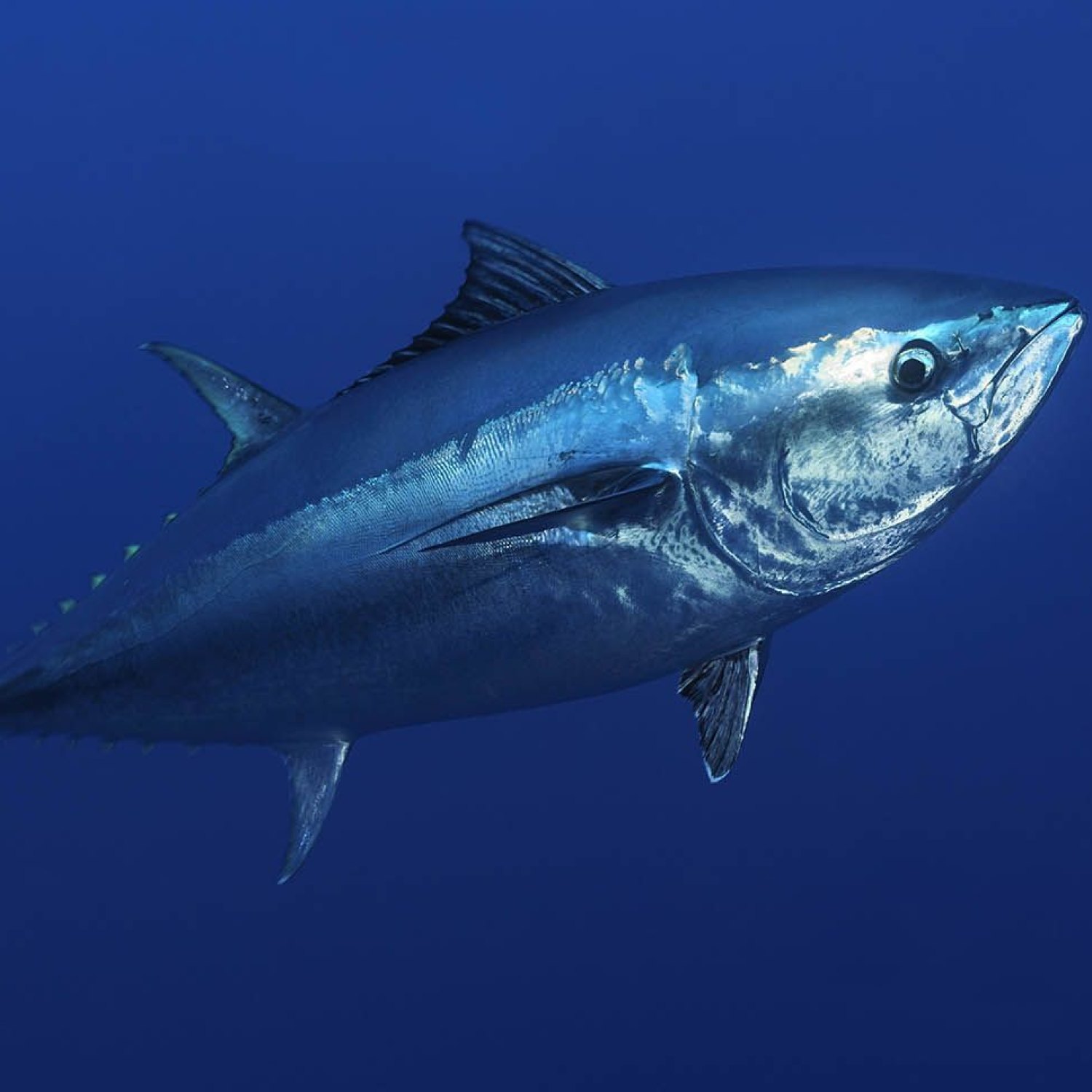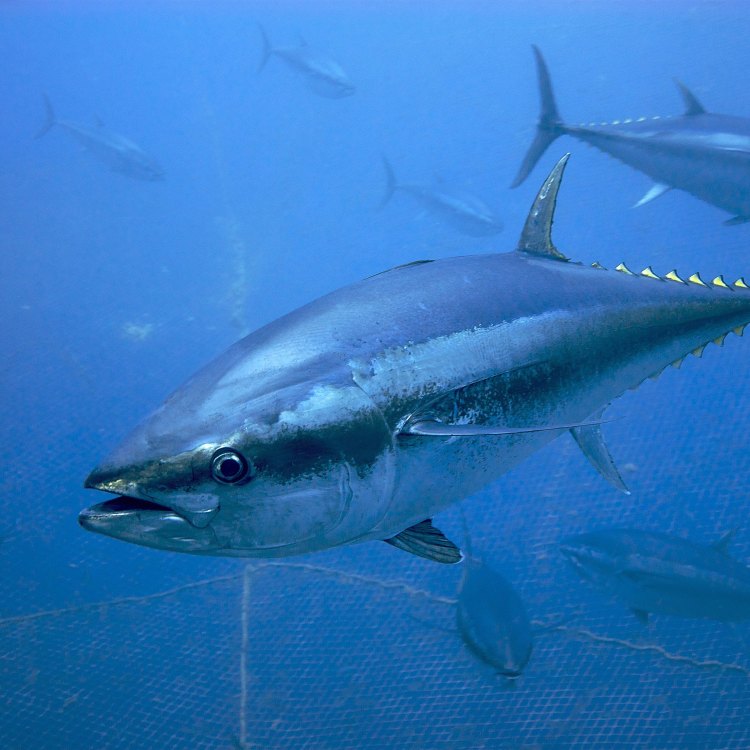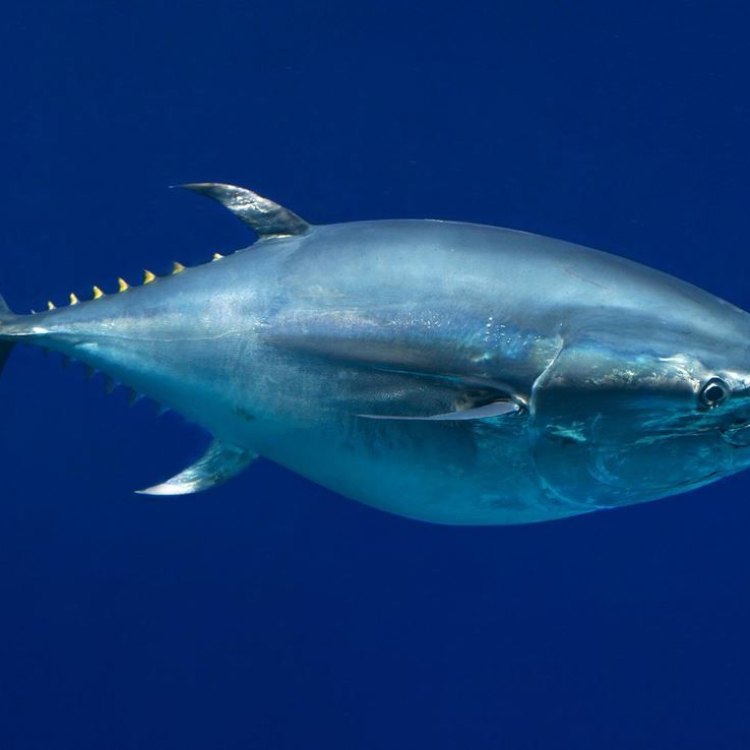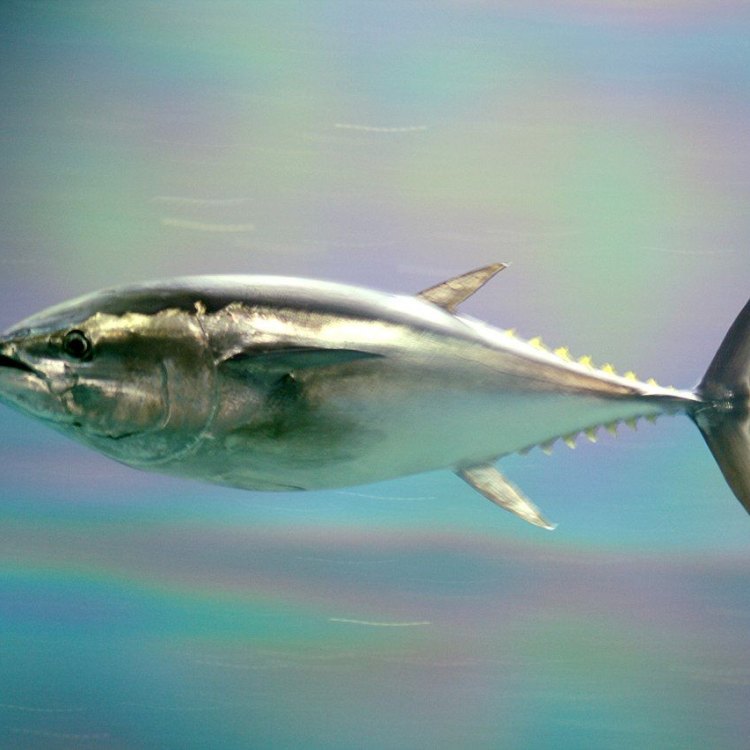
Bluefin Tuna
Up to 10 feet (3 meters)
Bluefin Tuna, known for its impressive size and speed, can grow up to 10 feet long and weigh over 1,000 pounds. This powerful fish is a prized catch for sport and commercial fishermen due to its delicious taste and high demand in the seafood market. These apex predators can be found in coastal and pelagic waters around the world, and belong to the Scombridae family. With their streamlined and torpedo-shaped bodies, Bluefin Tuna are truly a sight to behold in the open ocean.
Animal Details Summary:
Common Name: Bluefin Tuna
Kingdom: Animalia
Habitat: Open ocean
The Magnificent Bluefin Tuna: Facts, Habitat, and Importance
Few creatures rival the magnificence and resilience of the Bluefin Tuna. This mighty fish, known scientifically as Thunnus thynnus, is a highly coveted and sought-after species found in the open ocean. With a streamlined and torpedo-shaped body, blueish or silver coloration, and impressive size, the Bluefin Tuna is truly a sight to behold. In this article, we will delve further into the world of this awe-inspiring creature, exploring its habitat, feeding methods, geographical distribution, and more Bluefin Tuna. So, get ready to dive into the depths of the ocean and discover the wonders of the Bluefin Tuna.The Mighty Bluefin Tuna: A Member of the Animal Kingdom
Before we delve into the details of the Bluefin Tuna, let us first establish its place in the animal kingdom. This magnificent creature is classified under the Animal Kingdom, also known as Animalia. This kingdom is the largest category in biological classification, with over 1.5 million identified species. As a member of this kingdom, the Bluefin Tuna shares several characteristics with other animals, including being multicellular, having specialized cells, and possessing the ability to move and respond to stimuli.The Blueprint of the Bluefin Tuna: Phylum, Class, and Order
The Bluefin Tuna belongs to the phylum Chordata, which includes all animals with a notochord, a flexible rod running along their length. Other notable members of this phylum include mammals, birds, reptiles, amphibians, and fish. Within the phylum Chordata, the Bluefin Tuna falls under the class Actinopterygii, which includes ray-finned fish with bony skeletons and fins supported by thin, flexible rays Beauceron. As a member of this class, the Bluefin Tuna possesses many unique features, including its streamlined body and powerful fins that propel it through the ocean.The Bluefin Tuna also belongs to the order Perciformes, which includes over 41% of all fish species. This diverse order contains several families, including the Scombridae family, which the Bluefin Tuna calls home.
The Fascinating Habitat of the Bluefin Tuna
The Bluefin Tuna is a pelagic fish, meaning it spends most of its life in the open ocean. These majestic creatures can be found in the Atlantic and Mediterranean, making them a vital part of the marine ecosystem in these regions. They have also been reported in the Indian and Pacific Oceans, indicating a wide geographical distribution.Bluefin Tuna are highly migratory fish, moving through different ocean regions in search of food and suitable temperatures. They prefer coastal waters and are often found near continental shelves and seamounts. However, they can also venture out into deeper waters, where they feed on prey such as squid, mackerel, and crustaceans.
Feeding Methods of the Bluefin Tuna
As carnivorous fish, the Bluefin Tuna has a varied and hearty diet. They use their powerful jaws and sharp teeth to hunt and consume their prey. These fish are fast and agile swimmers, enabling them to chase and catch their prey efficiently. When hunting, they use their keen eyesight to locate their prey, and then they strike with lightning speed, often engulfing the prey whole.Bluefin Tuna are apex predators, meaning they are at the top of their food chain. They play a crucial role in the ocean's ecosystem by keeping populations of their prey in check.
The Colorful World of the Bluefin Tuna
The Bluefin Tuna is aptly named for its striking coloration. Their bodies are mostly blue or silver on top, blending in with the ocean's waters, and white or silver on the belly. This coloration serves as camouflage, allowing them to blend in with their surroundings and avoid detection by predators.However, the Bluefin Tuna's coloration is not just for protection. During spawning season, the males' coloration becomes more pronounced as they compete for females. They also display various color patterns during courtship rituals.
The Bluefin Tuna's Unique Body Shape and Size
The Bluefin Tuna has a unique body shape, resembling a torpedo. This design is incredibly efficient in the water, allowing them to move through the ocean with minimal effort. Their powerful muscular bodies also contribute to their swift movements, making them one of the fastest fish in the ocean.Bluefin Tuna can reach impressive lengths of up to 10 feet (3 meters) and weigh up to 1,400 pounds (650 kilograms). This size, coupled with their streamlined body shape, makes them formidable and awe-inspiring creatures.
The Conservation and Importance of Bluefin Tuna
The Bluefin Tuna's impressive size and unique characteristics have made it a highly sought-after species for centuries. However, this has led to overfishing, putting a strain on their population. In recent years, several measures have been put in place to conserve and protect the Bluefin Tuna, including catch quotas and stricter regulations on fishing methods.But, why is the Bluefin Tuna so important? Apart from being a vital part of the ocean's ecosystem, these fish also have significant economic importance. They are a valuable commodity in the global seafood market, with a single fish fetching a high price. They are also a popular sports fish, attracting anglers from all over the world.
Moreover, the Bluefin Tuna's migration patterns bring tourists to certain areas, boosting the economy and supporting local communities. Conservation efforts not only protect this majestic creature but also help sustain the livelihoods of many people.
In Conclusion
The Bluefin Tuna is truly a remarkable creature, with its unique characteristics, impressive size, and vital role in the ecosystem. As a member of the Animal Kingdom, this fish shares several traits with other animals, but its streamlined body and powerful fins make it a true marvel of the ocean. Though facing challenges, the Bluefin Tuna continues to swim through the vast open ocean, a testament to its endurance and resilience. Let us continue to appreciate and protect this magnificent species for generations to come.

Bluefin Tuna
Animal Details Bluefin Tuna - Scientific Name: Thunnus thynnus
- Category: Animals B
- Scientific Name: Thunnus thynnus
- Common Name: Bluefin Tuna
- Kingdom: Animalia
- Phylum: Chordata
- Class: Actinopterygii
- Order: Perciformes
- Family: Scombridae
- Habitat: Open ocean
- Feeding Method: Carnivorous
- Geographical Distribution: Atlantic and Mediterranean
- Country of Origin: Several countries
- Location: Coastal and pelagic waters
- Animal Coloration: Blueish or silver on top, white or silver on the belly
- Body Shape: Streamlined and torpedo-shaped
- Length: Up to 10 feet (3 meters)

Bluefin Tuna
- Adult Size: Up to 990 pounds (450 kilograms)
- Average Lifespan: Up to 40 years
- Reproduction: Sexual
- Reproductive Behavior: Spawning occurs in warm waters
- Sound or Call: Produces low frequency sounds
- Migration Pattern: Long-distance migrations
- Social Groups: Solitary or in small groups
- Behavior: Fast swimmers and highly migratory
- Threats: Overfishing, habitat destruction
- Conservation Status: Endangered
- Impact on Ecosystem: Top predators in the ocean ecosystem
- Human Use: Commercial and recreational fishing
- Distinctive Features: Large size, powerful body, and metallic blue coloration
- Interesting Facts: Bluefin tuna are known for their incredible speed and endurance, and can swim at speeds up to 40 miles per hour (64 kilometers per hour)
- Predator: Sharks and humans

Thunnus thynnus
The Mighty Bluefin Tuna: A Top Predator in Danger of Disappearing
The deep blue ocean holds many secrets, mysteries, and wonders. But one creature stands out among the rest, both in size and significance. With its impressive size, powerful body, and striking metallic blue coloration, the bluefin tuna is a legendary and awe-inspiring fish.The bluefin tuna, also known as "hon-meguro" in Japan, is a species of tuna found in the Atlantic, Pacific, and Indian Oceans PeaceOfAnimals.Com. They are found in warm and temperate waters, typically near the surface. This magnificent fish is highly prized for its delicious and fatty meat, making it a favorite among sushi-lovers and chefs worldwide. But the value placed on this fish has led to its rapid decline, and it is now listed as an endangered species.
In this article, we will dive deep into the world of bluefin tuna, exploring its unique features, behavior, threats, and impact on the ecosystem.
From Tiny Fry to Giant Fish: The Bluefin Tuna's Growth and Development
One of the most remarkable things about the bluefin tuna is its incredible size. As adults, they can reach weights of up to 990 pounds (450 kilograms), making them one of the largest and most powerful fish in the ocean. But their journey to reach this size is not an easy one.Bluefin tuna start their lives as tiny fry, measuring an average of just 0.08 inches (2 millimeters) Bullmastiff. As they grow, they undergo several stages of development, from larvae to juvenile to adulthood. During this time, they feed on plankton, small fish, and squid, rapidly increasing in size and strength.
It takes approximately 8-12 years for a bluefin tuna to reach its full adult size. They can live up to 40 years, with females typically living longer than males. As they mature, they develop their distinctive metallic blue coloration, making them easily recognizable among other tuna species.
Spawning: A Warm and Aggressive Affair
The bluefin tuna's reproductive behavior is also a unique and fascinating aspect of this fish. Unlike many other fish species, they are sexual and reproduce by spawning in warm waters.Female bluefin tuna can produce millions of eggs each season, but only a tiny fraction of these eggs will survive to maturity. These eggs are fertilized by male tuna, who release their sperm into the water during the spawning process.
Spawning contributes to the bluefin tuna's highly migratory nature as they travel to warm and tropical waters to reproduce. Interestingly, spawning can also affect the tuna's behavior and aggression levels. As they are in the midst of their reproductive cycle, they may become more protective and territorial, making them more likely to attack potential predators or competing fish.
Fast and Furious: The Bluefin Tuna's Incredible Speed and Migration
Bluefin tuna are known for their incredible speed and endurance, making them one of the most impressive swimmers in the ocean. They can swim at speeds of up to 40 miles per hour (64 kilometers per hour), making them a challenging catch for fishermen.Their speed also contributes to their migratory behavior. Bluefin tuna are highly migratory fish, making long-distance journeys across vast stretches of open ocean. They can travel thousands of miles, moving between different ocean regions in search of food and suitable spawning grounds.
This migratory behavior is crucial to the bluefin tuna's survival, as it allows them to access different food sources and maintain genetic diversity within the population. However, this behavior also puts them at increased risk of encountering threats and dangers along their journeys.
A Lone Wolf or a Small Pod: Exploring the Bluefin Tuna's Social Groups
While bluefin tuna are highly migratory fish, they are often solitary creatures. They may travel alone for long periods, only coming together in small groups when they are feeding or spawning. This solitary nature also means they do not form strong social bonds and do not exhibit complex social behaviors like other fish species.However, researchers have observed instances where bluefin tuna form small, temporary pods to hunt for food and protect themselves from predators. These pods typically consist of up to 20 individuals and disband once the purpose for grouping has ended.
The reasons for the bluefin tuna's solitary nature are still not fully understood. Still, scientists believe it may be due to the highly competitive and aggressive behavior they exhibit while hunting for food.
Aggressive Predators and Overfishing: The Threats Facing the Bluefin Tuna
Despite their impressive size and speed, the bluefin tuna still face significant threats to their survival. The main and most pressing threat is overfishing. Bluefin tuna are highly sought after for their prized meat and can fetch astronomical prices on the market, making them a highly lucrative catch for fishermen.The demand for bluefin tuna has led to extensive overfishing, with estimates stating that the population has declined by 60-90% in the past few decades. Coupled with their slow growth and maturity rates, as well as their long migrations, this rapid decline in population has caused great concern for the species' survival.
In addition to overfishing, bluefin tuna also face threats from habitat destruction and pollution. As they rely on clean, warm waters for spawning and feeding, pollution and habitat destruction can severely impact their survival and reproductive success.
Endangered and Essential: The Conservation Status and Importance of Bluefin Tuna
The rapid decline in bluefin tuna population has resulted in them being classified as an endangered species. This designation means that the species is at risk of extinction without intervention and conservation efforts.Several organizations and initiatives are working towards protecting and conserving the bluefin tuna. These efforts include implementing stricter fishing quotas, promoting sustainable fishing practices, and advocating for the protection and restoration of their habitats.
But why is it essential to conserve the bluefin tuna? Apart from their economic value, bluefin tuna play a vital role in the ocean ecosystem. As top predators, they help maintain a balance in the food chain. They also contribute to the movement and distribution of nutrients in the ocean, making them crucial for the health and functioning of the marine ecosystem.
A Human-Driven Threat: The Impact of Commercial and Recreational Fishing on Bluefin Tuna
Humans play a significant role in the decline of bluefin tuna population. Apart from overfishing, commercial and recreational fishing also impact the species' survival and reproductive success.Commercial fishing techniques such as longlining, purse seining, and gillnetting have a high bycatch rate, meaning they catch not just the targeted tuna but also other marine animals like dolphins, sea turtles, and sharks. This bycatch can result in the unintentional harm and deaths of thousands of non-targeted species, further disrupting the balance of the ocean ecosystem.
Recreational fishing, while not as large-scale as commercial fishing, can also have a significant impact on bluefin tuna populations. Unregulated and unreported recreational fishing can lead to the overexploitation of these fish and contribute to their decline.
As consumers, we also have a responsibility to ensure that the seafood we eat is sustainably sourced. By choosing to support sustainable fishing practices and avoiding fish from overfished populations, we can make a positive impact on the survival of bluefin tuna and other threatened species.
From Top Predator to Endangered Species: The Troubling Decline of Bluefin Tuna
In just a few decades, the bluefin tuna population has decreased significantly, earning its status as an endangered species. This decline is a direct result of human actions, namely overfishing and habitat destruction. But it's not too late to save these magnificent creatures.Conservation efforts and sustainable fishing practices are essential for the bluefin tuna's survival and the balance of the marine ecosystem. As consumers, we can also make a difference by being mindful of the seafood we consume and supporting responsible fishing practices.
These efforts, combined with effective management and enforcement of fishing regulations, can help ensure that the bluefin tuna's impressive size, speed, and striking appearance continue to grace our oceans for years to come. Let us all do our part to prevent the disappearance of this mighty and essential top predator.

The Magnificent Bluefin Tuna: Facts, Habitat, and Importance
Disclaimer: The content provided is for informational purposes only. We cannot guarantee the accuracy of the information on this page 100%. All information provided here may change without prior notice.












